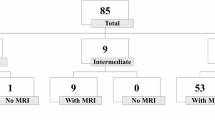Abstract
Background
The association between spinal cord anomalies and imperforate anus is well recognized. Until now, the incidence of tethered cord has been assumed to be higher in patients with high-type imperforate anus. However, recent reports suggest that tethered cord is as common in patients with a low lesion as in those with a high lesion.
Objective
To review the incidence of spinal cord anomalies in those with a low lesion and those with a high (including intermediate) anorectal malformation (ARM), and to determine the best diagnostic imaging strategy.
Materials and methods
A group of 50 consecutive patients with postoperative ARM and in whom spinal MRI had been performed were identified retrospectively. We reviewed and compared the following factors between those with a high lesion and those with a low lesion: (1) clinical symptoms, (2) spinal cord anomalies, and (3) vertebral anomalies.
Results
The incidence of spinal cord anomalies was no different between those with a high lesion and those with a low lesion, and spinal cord anomalies were present regardless of the presence of vertebral anomalies or symptoms.
Conclusion
Owing to the high incidence of spinal cord anomalies in patients with imperforate anus, MRI is the best imaging tool for detecting such anomalies regardless of the level of the lesion.





Similar content being viewed by others
Explore related subjects
Discover the latest articles and news from researchers in related subjects, suggested using machine learning.References
Nievelstein RA, Vos A, Valk J (1998) MR imaging of anorectal malformations and associated anomalies. Eur Radiol 8:573–581
Leonidas JC, Singh SP, Slovis TL (2004) Anomalies of the colon and anorectal area. In: Kuhn JP, Slovis TL, Haller JO (eds) Caffey’s pediatric diagnostic imaging, 10th edn. Mosby, Philadelphia, pp 140–149
De Gennaro M, Rivosecchi M, Lucchetti MC et al (1994) The incidence of occult spinal dysraphism and the onset of neurovesical dysfunction in children with anorectal anomalies. Eur J Pediatr Surg 4(Suppl 1):12–14
Golonka NR, Haga LJ, Keating RP et al (2002) Routine MRI evaluation of low imperforate anus reveals unexpected high incidence of tethered spinal cord. J Pediatr Surg 37:966–969
Mosiello G, Capitanucci ML, Capitanucci ML et al (2003) How to investigate neurovesical dysfunction in children with anorectal malformations. J Urol 170:1610–1613
Barkovich AJ (2000) Congenital anomalies of the spine. In: Barkovich AJ (ed) Pediatric neuroimaging, 4th edn. Lippincott Williams & Wilkins, Philadelphia, pp 704–772
Endo M, Hayashi A, Ishihara M et al (1999) Analysis of 1,992 patients with anorectal malformations over the past two decades in Japan. Steering Committee of Japanese Study Group of Anorectal Anomalies. J Pediatr Surg 34:435–441
Tsakayannis DE, Shamberger RC (1995) Association of imperforate anus with occult spinal dysraphism. J Pediatr Surg 30:1010–1012
Long FR, Hunter JV, Mahboubi S et al (1996) Tethered cord and associated vertebral anomalies in children and infants with imperforate anus: evaluation with MR imaging and plain radiography. Radiology 200:377–382
Tsuda T, Iwai N, Kimura O et al (2007) Bowel function after surgery for anorectal malformations in patients with tethered spinal cord. Pediatr Surg Int 23:1171–1174
Jia H, Zhang K, Zhang S et al (2007) Quantitative analysis of sacral parasympathetic nucleus innervating the rectum in rats with anorectal malformation. J Pediatr Surg 42:1544–1548
Nievelstein RA, Vos A, Valk J et al (2002) Magnetic resonance imaging in children with anorectal malformations: embryologic implications. J Pediatr Surg 37:1138–1145
Morimoto K, Takemoto O, Wakayama A (2003) Tethered cord association with anorectal malformation. Pediatr Neurosurg 38:79–82
Tuuha SE, Aziz D, Drake J et al (2004) Is surgery necessary for asymptomatic tethered cord in anorectal malformation patients? J Pediatr Surg 39:773–777
Heij HA, Nievelstein RA, de Zwart I et al (1996) Abnormal anatomy of the lumbosacral region imaged by magnetic resonance in children with anorectal malformations. Arch Dis Child 74:441–444
Hsieh MH, Perry V, Gupta N et al (2006) The effects of detethering on the urodynamics profile in children with a tethered cord. J Neurosurg 105(5 suppl):391–395
Uchida K, Inoue M, Matsubara T et al (2007) Evaluation and treatment for spinal cord tethering in patients with anorectal malformations. Eur J Pediatr Surg 17:408–411
Author information
Authors and Affiliations
Corresponding author
Rights and permissions
About this article
Cite this article
Miyasaka, M., Nosaka, S., Kitano, Y. et al. Utility of spinal MRI in children with anorectal malformation. Pediatr Radiol 39, 810–816 (2009). https://doi.org/10.1007/s00247-009-1287-5
Received:
Revised:
Accepted:
Published:
Issue Date:
DOI: https://doi.org/10.1007/s00247-009-1287-5



